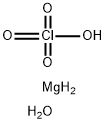STRONTIUM PERCHLORATE
- CAS NO.:13450-97-0
- Empirical Formula: Cl2O8Sr
- Molecular Weight: 286.52
- MDL number: MFCD00049547
- EINECS: 236-614-2
- SAFETY DATA SHEET (SDS)
- Update Date: 2024-12-18 14:08:57

What is STRONTIUM PERCHLORATE?
Chemical properties
white crystal(s); hygroscopic [STR93]
Physical properties
Strontium perchlorate has the formula, Sr(ClO4)2 and
a molecular weight of 286.52 g/mol. It is a white solid
with a melting point of 100°C. Its density is 2.073 g/
cm3 and it is lightly soluble in water (3.21 g/100 ml at
20°C). It can be prepared by reaction of strontium
carbonate with a solution of perchloric acid or ammonium
perchlorate:
SrCO3+ 2HClO4→Sr(ClO4)2+H2O+ CO2
In an aqueous solution, the hexahydrate results.
Sr(ClO4)2·6H2O has the molecular weight of 394.63 g/
mol and a CAS number of 13450-97-0. A trihydrate,
Sr(ClO4)2·3H2O is also known, having the molecular
weight of 340.57 g/mol and a CAS number of 15650-
09-6.
General Description
A colorless crystalline powder. Dangerous fire risk when in contact with organic materials. Used to make other chemicals.
Air & Water Reactions
Denser than water and soluble in water.
Reactivity Profile
Oxidizing agents, such as STRONTIUM PERCHLORATE, can react with reducing agents to generate heat and products that may be gaseous (causing pressurization of closed containers). The products may themselves be capable of further reactions (such as combustion in the air). The chemical reduction of materials in this group can be rapid or even explosive, but often requires initiation (heat, spark, catalyst, addition of a solvent). Explosive mixtures of inorganic oxidizing agents with reducing agents often persist unchanged for long periods if initiation is prevented. Such systems are typically mixtures of solids, but may involve any combination of physical states. Some inorganic oxidizing agents are salts of metals that are soluble in water; dissolution dilutes but does not nullify the oxidizing power of such materials. Organic compounds, in general, have some reducing power and can in principle react with compounds in this class. Actual reactivity varies greatly with the identity of the organic compound. Inorganic oxidizing agents can react violently with active metals, cyanides, esters, and thiocyanates.
Health Hazard
Inhalation, ingestion or contact (skin, eyes) with vapors or substance may cause severe injury, burns or death. Fire may produce irritating, corrosive and/or toxic gases. Runoff from fire control or dilution water may cause pollution.
Fire Hazard
These substances will accelerate burning when involved in a fire. Some may decompose explosively when heated or involved in a fire. May explode from heat or contamination. Some will react explosively with hydrocarbons (fuels). May ignite combustibles (wood, paper, oil, clothing, etc.). Containers may explode when heated. Runoff may create fire or explosion hazard.
Properties of STRONTIUM PERCHLORATE
| Melting point: | <100°C |
| solubility | soluble in ethanol, methanol |
| form | crystal |
| color | white |
| Water Solubility | mol/kg H2O: 8.16 (0°C), 10.67 (25°C), 12.70 (40°C); solid phase, Sr(ClO4)2 · 4H2O (0°C), Sr(ClO4)2 ·2H2O (25°C), 3Sr(ClO4)2 · 2H2O (above 40°C) [KRU93]; soluble alcohol [HAW93] |
| Stability: | hygroscopic |
| CAS DataBase Reference | 13450-97-0(CAS DataBase Reference) |
| EPA Substance Registry System | Perchloric acid, strontium salt (13450-97-0) |
Safety information for STRONTIUM PERCHLORATE
Computed Descriptors for STRONTIUM PERCHLORATE
New Products
4-Fluorophenylacetic acid 4-Methylphenylacetic acid N-Boc-D-alaninol N-BOC-D/L-ALANINOL Tert-butyl bis(2-chloroethyl)carbamate 3-Morpholino-1-(4-nitrophenyl)-5,6-dihydropyridin- 2(1H)-one Furan-2,5-Dicarboxylic Acid Tropic acid S-2-CHLORO PROPIONIC ACID ETHYL ISOCYANOACETATE 2-Bromo-1,3-Bis(Dimethylamino)Trimethinium Hexafluorophosphate (6-METHYL-[1,3]DITHIOLO[4,5-b]QUINOXALIN-2-ONE INDAZOLE-3-CARBOXYLIC ACID 4-IODO BENZOIC ACID (2-Hydroxyphenyl)acetonitrile 4-Bromopyrazole 5,6-Dimethoxyindanone 2-(Cyanocyclohexyl)acetic acid 4-methoxy-3,5-dinitropyridine 2-aminopropyl benzoate hydrochloride 1-(4-(aminomethyl)benzyl)urea hydrochloride diethyl 2-(2-((tertbutoxycarbonyl)amino) ethyl)malonate tert-butyl 4- (ureidomethyl)benzylcarbamate Ethyl-2-chloro((4-methoxyphenyl)hydrazono)acetateRelated products of tetrahydrofuran








You may like
-
 2033-24-1 98%View Details
2033-24-1 98%View Details
2033-24-1 -
 42831-50-5 5-METHYLISOXAZOLE-4-CARBOXYLIC ACID 98%View Details
42831-50-5 5-METHYLISOXAZOLE-4-CARBOXYLIC ACID 98%View Details
42831-50-5 -
 1975-50-4 98%View Details
1975-50-4 98%View Details
1975-50-4 -
 2-HYDROXY BENZYL ALCOHOL 98%View Details
2-HYDROXY BENZYL ALCOHOL 98%View Details
90-01-7 -
 2-Chloro-1,3-Bis(Dimethylamino)Trimethinium Hexafluorophosphate 221615-75-4 98%View Details
2-Chloro-1,3-Bis(Dimethylamino)Trimethinium Hexafluorophosphate 221615-75-4 98%View Details
221615-75-4 -
 61397-56-6 CIS BROMO BENZOATE 98%View Details
61397-56-6 CIS BROMO BENZOATE 98%View Details
61397-56-6 -
 14714-50-2 (2-Hydroxyphenyl)acetonitrile 98+View Details
14714-50-2 (2-Hydroxyphenyl)acetonitrile 98+View Details
14714-50-2 -
 118753-70-1 98+View Details
118753-70-1 98+View Details
118753-70-1